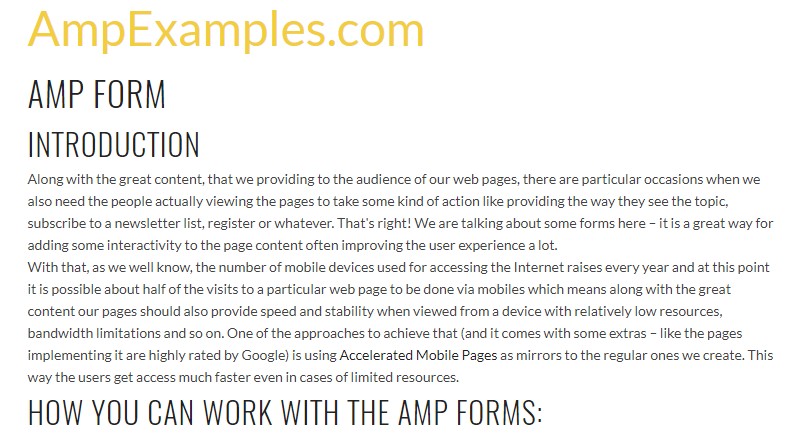Bootstrap Form Example
Intro
Bootstrap provides a handful of form command styles, layout opportunities, plus custom made components for producing a variety of Bootstrap Form Input.
Forms give the most ideal option for receiving several responses directly from the site visitors of our pages. In case that it is definitely a basic contact or subscription form together with simply a couple of areas or a highly developed and properly thought query the Bootstrap 4 platform got everything that's really needed to finish the job and obtain wonderful responsive appearance.
By default when it comes to the Bootstrap framework the form features are designated to span the entire width of its parent feature-- this gets reached by authorizing the .form-control class. The managements and lebels should be wrapped inside a parent element along with the .form-group class for effective spacing.
Bootstrap Form Button controls
Bootstrap's form controls extend upon our Rebooted form designs along with classes.
Use such classes to opt in to their customized displays to get a more consistent rendering across gadgets and browsers . The sample form here displays typical HTML form features that obtain refreshed looks directly from Bootstrap along with additional classes.
Take note, due to the fact that Bootstrap applies the HTML5 doctype, all of the inputs need to provide a type attribute.
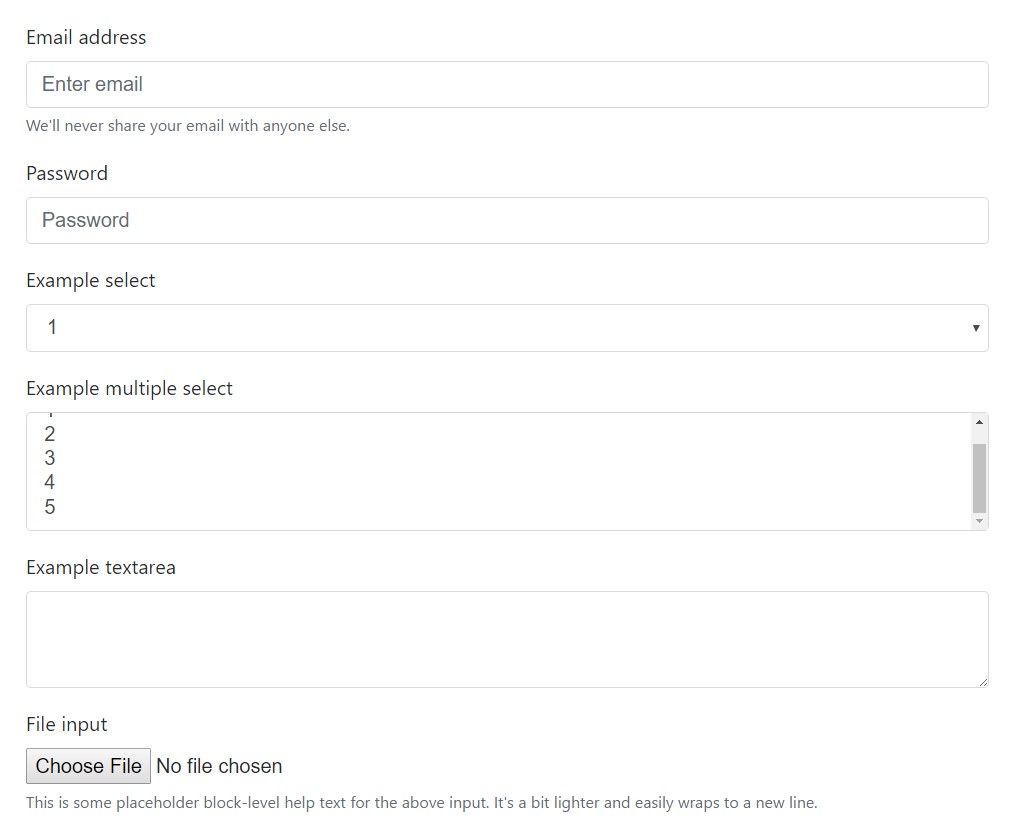

<form>
<div class="form-group">
<label for="exampleInputEmail1">Email address</label>
<input type="email" class="form-control" id="exampleInputEmail1" aria-describedby="emailHelp" placeholder="Enter email">
<small id="emailHelp" class="form-text text-muted">We'll never share your email with anyone else.</small>
</div>
<div class="form-group">
<label for="exampleInputPassword1">Password</label>
<input type="password" class="form-control" id="exampleInputPassword1" placeholder="Password">
</div>
<div class="form-group">
<label for="exampleSelect1">Example select</label>
<select class="form-control" id="exampleSelect1">
<option>1</option>
<option>2</option>
<option>3</option>
<option>4</option>
<option>5</option>
</select>
</div>
<div class="form-group">
<label for="exampleSelect2">Example multiple select</label>
<select multiple class="form-control" id="exampleSelect2">
<option>1</option>
<option>2</option>
<option>3</option>
<option>4</option>
<option>5</option>
</select>
</div>
<div class="form-group">
<label for="exampleTextarea">Example textarea</label>
<textarea class="form-control" id="exampleTextarea" rows="3"></textarea>
</div>
<div class="form-group">
<label for="exampleInputFile">File input</label>
<input type="file" class="form-control-file" id="exampleInputFile" aria-describedby="fileHelp">
<small id="fileHelp" class="form-text text-muted">This is some placeholder block-level help text for the above input. It's a bit lighter and easily wraps to a new line.</small>
</div>
<fieldset class="form-group">
<legend>Radio buttons</legend>
<div class="form-check">
<label class="form-check-label">
<input type="radio" class="form-check-input" name="optionsRadios" id="optionsRadios1" value="option1" checked>
Option one is this and that—be sure to include why it's great
</label>
</div>
<div class="form-check">
<label class="form-check-label">
<input type="radio" class="form-check-input" name="optionsRadios" id="optionsRadios2" value="option2">
Option two can be something else and selecting it will deselect option one
</label>
</div>
<div class="form-check disabled">
<label class="form-check-label">
<input type="radio" class="form-check-input" name="optionsRadios" id="optionsRadios3" value="option3" disabled>
Option three is disabled
</label>
</div>
</fieldset>
<div class="form-check">
<label class="form-check-label">
<input type="checkbox" class="form-check-input">
Check me out
</label>
</div>
<button type="submit" class="btn btn-primary">Submit</button>
</form>Listed below is a finished list of the unique Bootstrap Form Template controls promoted by Bootstrap as well as the classes that customize them. Added information is accessible for each group.
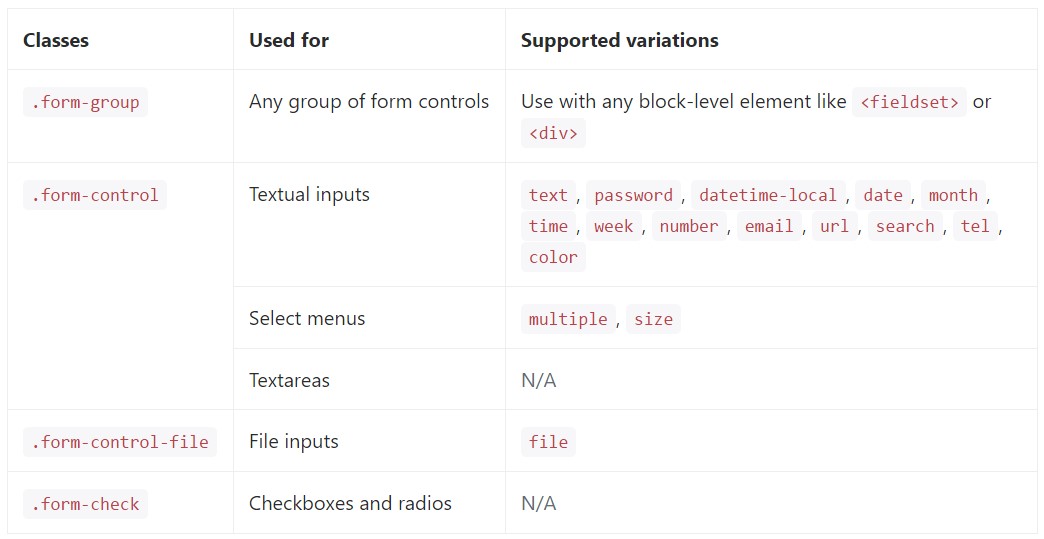
Textual inputs
Here are the examples of .form-control related to every textual HTML5 <input> type.
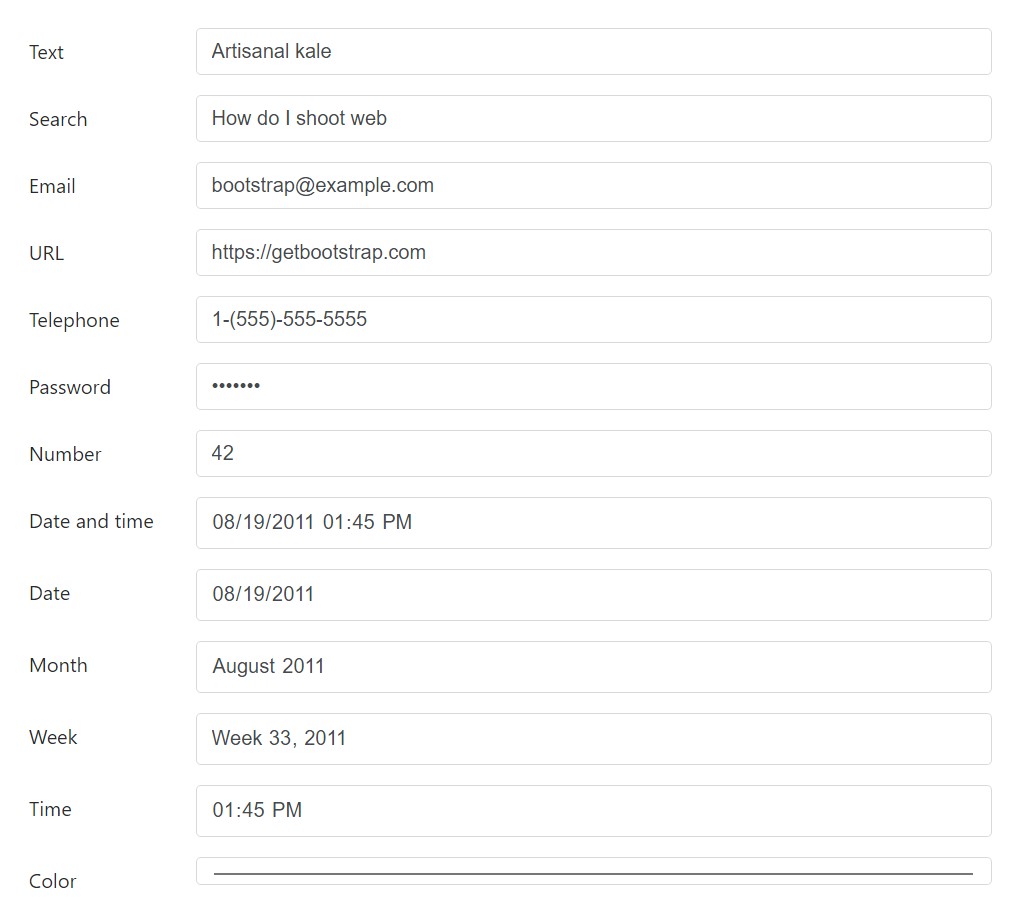
<div class="form-group row">
<label for="example-text-input" class="col-2 col-form-label">Text</label>
<div class="col-10">
<input class="form-control" type="text" value="Artisanal kale" id="example-text-input">
</div>
</div>
<div class="form-group row">
<label for="example-search-input" class="col-2 col-form-label">Search</label>
<div class="col-10">
<input class="form-control" type="search" value="How do I shoot web" id="example-search-input">
</div>
</div>
<div class="form-group row">
<label for="example-email-input" class="col-2 col-form-label">Email</label>
<div class="col-10">
<input class="form-control" type="email" value="[email protected]" id="example-email-input">
</div>
</div>
<div class="form-group row">
<label for="example-url-input" class="col-2 col-form-label">URL</label>
<div class="col-10">
<input class="form-control" type="url" value="https://getbootstrap.com" id="example-url-input">
</div>
</div>
<div class="form-group row">
<label for="example-tel-input" class="col-2 col-form-label">Telephone</label>
<div class="col-10">
<input class="form-control" type="tel" value="1-(555)-555-5555" id="example-tel-input">
</div>
</div>
<div class="form-group row">
<label for="example-password-input" class="col-2 col-form-label">Password</label>
<div class="col-10">
<input class="form-control" type="password" value="hunter2" id="example-password-input">
</div>
</div>
<div class="form-group row">
<label for="example-number-input" class="col-2 col-form-label">Number</label>
<div class="col-10">
<input class="form-control" type="number" value="42" id="example-number-input">
</div>
</div>
<div class="form-group row">
<label for="example-datetime-local-input" class="col-2 col-form-label">Date and time</label>
<div class="col-10">
<input class="form-control" type="datetime-local" value="2011-08-19T13:45:00" id="example-datetime-local-input">
</div>
</div>
<div class="form-group row">
<label for="example-date-input" class="col-2 col-form-label">Date</label>
<div class="col-10">
<input class="form-control" type="date" value="2011-08-19" id="example-date-input">
</div>
</div>
<div class="form-group row">
<label for="example-month-input" class="col-2 col-form-label">Month</label>
<div class="col-10">
<input class="form-control" type="month" value="2011-08" id="example-month-input">
</div>
</div>
<div class="form-group row">
<label for="example-week-input" class="col-2 col-form-label">Week</label>
<div class="col-10">
<input class="form-control" type="week" value="2011-W33" id="example-week-input">
</div>
</div>
<div class="form-group row">
<label for="example-time-input" class="col-2 col-form-label">Time</label>
<div class="col-10">
<input class="form-control" type="time" value="13:45:00" id="example-time-input">
</div>
</div>
<div class="form-group row">
<label for="example-color-input" class="col-2 col-form-label">Color</label>
<div class="col-10">
<input class="form-control" type="color" value="#563d7c" id="example-color-input">
</div>
</div>Form designs
Due to the fact that Bootstrap employs display: block and width :100% to almost all our form controls, forms will definitely by default stack vertically. Alternative classes may possibly be operated to change this layout on a per-form basis.
Form categories
The .form-group class is the best way to put in unusual building to forms. Its only function is to provide margin-bottom about a label and manage coupling. Just as a bonus, given that it is really a class you can utilize it with <fieldset>-s, <div>-s, or nearly other component.

<form>
<div class="form-group">
<label for="formGroupExampleInput">Example label</label>
<input type="text" class="form-control" id="formGroupExampleInput" placeholder="Example input">
</div>
<div class="form-group">
<label for="formGroupExampleInput2">Another label</label>
<input type="text" class="form-control" id="formGroupExampleInput2" placeholder="Another input">
</div>
</form>Inline forms
Make use of the .form-inline class to feature a series of labels, form managements , as well as tabs on a individual horizontal row. Form controls just within inline forms can be different a bit against their default forms.
- Controls are display: flex, breaking all HTML white territory and permitting you to supply positioning control including spacing and also flexbox utilities.
- Controls as well as input groups get width: auto to bypass the Bootstrap default width: 100%.
- Controls exclusively appear inline inside viewports which are at least 576px large to represent narrow viewports on mobile devices.
You may likely need to manually manage the size and arrangement of specific form controls having spacing utilities ( just as revealed below) Finally, make sure to always provide a <label> together with every form control, whether or not you ought to disguise it from non-screenreader website visitors with a code.

<form class="form-inline">
<label class="sr-only" for="inlineFormInput">Name</label>
<input type="text" class="form-control mb-2 mr-sm-2 mb-sm-0" id="inlineFormInput" placeholder="Jane Doe">
<label class="sr-only" for="inlineFormInputGroup">Username</label>
<div class="input-group mb-2 mr-sm-2 mb-sm-0">
<div class="input-group-addon">@</div>
<input type="text" class="form-control" id="inlineFormInputGroup" placeholder="Username">
</div>
<div class="form-check mb-2 mr-sm-2 mb-sm-0">
<label class="form-check-label">
<input class="form-check-input" type="checkbox"> Remember me
</label>
</div>
<button type="submit" class="btn btn-primary">Submit</button>
</form>Customized form controls also selects are likewise maintained.

<form class="form-inline">
<label class="mr-sm-2" for="inlineFormCustomSelect">Preference</label>
<select class="custom-select mb-2 mr-sm-2 mb-sm-0" id="inlineFormCustomSelect">
<option selected>Choose...</option>
<option value="1">One</option>
<option value="2">Two</option>
<option value="3">Three</option>
</select>
<label class="custom-control custom-checkbox mb-2 mr-sm-2 mb-sm-0">
<input type="checkbox" class="custom-control-input">
<span class="custom-control-indicator"></span>
<span class="custom-control-description">Remember my preference</span>
</label>
<button type="submit" class="btn btn-primary">Submit</button>
</form>Alternatives to covered labels
Assistive modern technologies including screen readers will certainly have difficulty along with your forms in the case that you don't feature a label for each input. For these particular inline forms, you can surely cover the labels working with the .sr-only class. There are further other options of presenting a label for assistive technologies, for example, the aria-label, aria-labelledby or title attribute. If not one of these exist, assistive technologies can invoke using the placeholder attribute, in the case that available, and yet consider that usage of placeholder as a replacement for some other labelling solutions is not really suggested.
Working with the Grid
For additionally structured form layouts that are as well responsive, you have the ability to use Bootstrap's predefined grid classes or possibly mixins to set up horizontal forms. Add the .row class to form groups and employ the .col-*-* classes in order to specify the width of your controls and labels.
Be sure to add .col-form-label to your <label>-s as well so they’re vertically centered with their associated form controls. For <legend> elements, you can use .col-form-legend to make them appear similar to regular <label> elements.
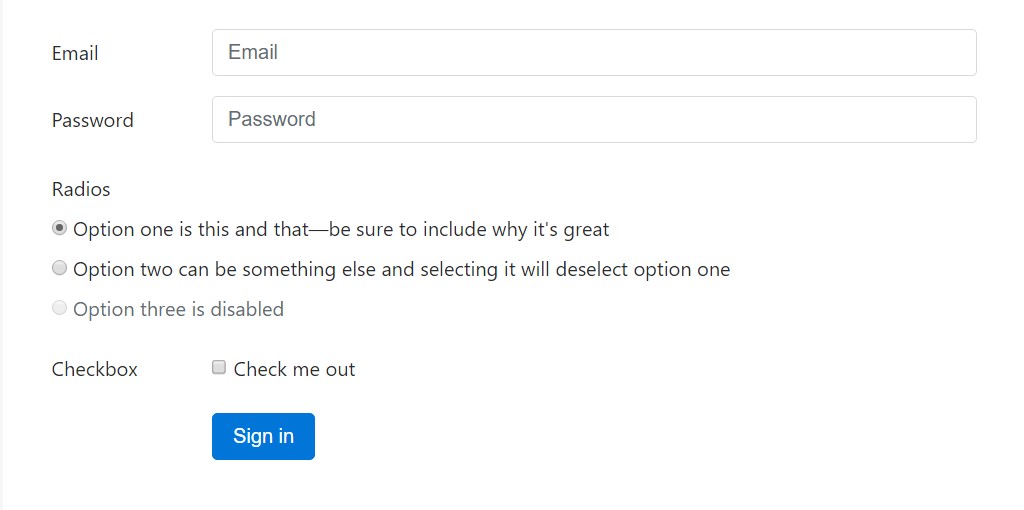
<div class="container">
<form>
<div class="form-group row">
<label for="inputEmail3" class="col-sm-2 col-form-label">Email</label>
<div class="col-sm-10">
<input type="email" class="form-control" id="inputEmail3" placeholder="Email">
</div>
</div>
<div class="form-group row">
<label for="inputPassword3" class="col-sm-2 col-form-label">Password</label>
<div class="col-sm-10">
<input type="password" class="form-control" id="inputPassword3" placeholder="Password">
</div>
</div>
<fieldset class="form-group row">
<legend class="col-form-legend col-sm-2">Radios</legend>
<div class="col-sm-10">
<div class="form-check">
<label class="form-check-label">
<input class="form-check-input" type="radio" name="gridRadios" id="gridRadios1" value="option1" checked>
Option one is this and that—be sure to include why it's great
</label>
</div>
<div class="form-check">
<label class="form-check-label">
<input class="form-check-input" type="radio" name="gridRadios" id="gridRadios2" value="option2">
Option two can be something else and selecting it will deselect option one
</label>
</div>
<div class="form-check disabled">
<label class="form-check-label">
<input class="form-check-input" type="radio" name="gridRadios" id="gridRadios3" value="option3" disabled>
Option three is disabled
</label>
</div>
</div>
</fieldset>
<div class="form-group row">
<label class="col-sm-2">Checkbox</label>
<div class="col-sm-10">
<div class="form-check">
<label class="form-check-label">
<input class="form-check-input" type="checkbox"> Check me out
</label>
</div>
</div>
</div>
<div class="form-group row">
<div class="offset-sm-2 col-sm-10">
<button type="submit" class="btn btn-primary">Sign in</button>
</div>
</div>
</form>
</div>Grid-based form configurations as well sustain small-sized and large inputs.

<div class="container">
<form>
<div class="form-group row">
<label for="lgFormGroupInput" class="col-sm-2 col-form-label col-form-label-lg">Email</label>
<div class="col-sm-10">
<input type="email" class="form-control form-control-lg" id="lgFormGroupInput" placeholder="[email protected]">
</div>
</div>
<div class="form-group row">
<label for="smFormGroupInput" class="col-sm-2 col-form-label col-form-label-sm">Email</label>
<div class="col-sm-10">
<input type="email" class="form-control form-control-sm" id="smFormGroupInput" placeholder="[email protected]">
</div>
</div>
</form>
</div>Checkboxes and radios
Default radios and checkboxes are greatly enhanced upon with the assistance of .form-check, a single class for both of these input types that enhances the layout and behaviour of their HTML components. Checkboxes are for picking one as well as a number of options inside a selection, while at the same time radios are for selecting just one capability from many.
The disabled class is going to also make lighter the text message color to help signify the input's state.
Each and every checkbox and radio is wrapped inside a <label> because of three causes:
- It delivers a larger hit areas for checking the control.
- It supplies a semantic and handy wrapper in order to help us substitute the default <input>-s.
- It leads to the state of the <input> instantly, signifying no JavaScript is involved.
We cover up the default <input> along with opacity and apply the .custom-control-indicator to set up a new custom made form indicator in its place. However we aren't able to set up a customized one because of just the <input> because CSS's content does not perform on that element..
We utilize the sibling selector (~) for all our <input> states-- like : checked-- in order to efficiently style our customized form sign . When combined with the .custom-control-description class, we have the ability to additionally design the text message for every item formed on the <input>-s state.
In the checked states, we use base64 embedded SVG icons from Open Iconic. This provides us the best control for styling and positioning across browsers and devices.
Checkboxes

<label class="custom-control custom-checkbox">
<input type="checkbox" class="custom-control-input">
<span class="custom-control-indicator"></span>
<span class="custom-control-description">Check this custom checkbox</span>
</label>Customized checkboxes are able to in addition apply the : indeterminate pseudo class once manually set up with JavaScript (there is definitely no accessible HTML attribute for identifying it).

In the event that you are actually using jQuery, something such as this should be enough:
$('.your-checkbox').prop('indeterminate', true)Radios

<label class="custom-control custom-radio">
<input id="radio1" name="radio" type="radio" class="custom-control-input">
<span class="custom-control-indicator"></span>
<span class="custom-control-description">Toggle this custom radio</span>
</label>
<label class="custom-control custom-radio">
<input id="radio2" name="radio" type="radio" class="custom-control-input">
<span class="custom-control-indicator"></span>
<span class="custom-control-description">Or toggle this other custom radio</span>
</label>Default (stacked)
By default, any number of checkboxes and radios that are actually immediate sibling will be vertically piled as well as properly spaced using .form-check.

<div class="form-check">
<label class="form-check-label">
<input class="form-check-input" type="checkbox" value="">
Option one is this and that—be sure to include why it's great
</label>
</div>
<div class="form-check disabled">
<label class="form-check-label">
<input class="form-check-input" type="checkbox" value="" disabled>
Option two is disabled
</label>
</div>
<div class="form-check">
<label class="form-check-label">
<input class="form-check-input" type="radio" name="exampleRadios" id="exampleRadios1" value="option1" checked>
Option one is this and that—be sure to include why it's great
</label>
</div>
<div class="form-check">
<label class="form-check-label">
<input class="form-check-input" type="radio" name="exampleRadios" id="exampleRadios2" value="option2">
Option two can be something else and selecting it will deselect option one
</label>
</div>
<div class="form-check disabled">
<label class="form-check-label">
<input class="form-check-input" type="radio" name="exampleRadios" id="exampleRadios3" value="option3" disabled>
Option three is disabled
</label>
</div>Inline
Group checkboxes or radios on the exact same horizontal row by adding .form-check-inline to every .form-check.

<div class="form-check form-check-inline">
<label class="form-check-label">
<input class="form-check-input" type="checkbox" id="inlineCheckbox1" value="option1"> 1
</label>
</div>
<div class="form-check form-check-inline">
<label class="form-check-label">
<input class="form-check-input" type="checkbox" id="inlineCheckbox2" value="option2"> 2
</label>
</div>
<div class="form-check form-check-inline disabled">
<label class="form-check-label">
<input class="form-check-input" type="checkbox" id="inlineCheckbox3" value="option3" disabled> 3
</label>
</div>
<div class="form-check form-check-inline">
<label class="form-check-label">
<input class="form-check-input" type="radio" name="inlineRadioOptions" id="inlineRadio1" value="option1"> 1
</label>
</div>
<div class="form-check form-check-inline">
<label class="form-check-label">
<input class="form-check-input" type="radio" name="inlineRadioOptions" id="inlineRadio2" value="option2"> 2
</label>
</div>
<div class="form-check form-check-inline disabled">
<label class="form-check-label">
<input class="form-check-input" type="radio" name="inlineRadioOptions" id="inlineRadio3" value="option3" disabled> 3
</label>
</div>Without having labels
You should not have a text message within the <label>, the input is positioned as you would most likely need. Right now strictly deals with non-inline checkboxes and radios. Bear in mind to also present some type of label for assistive systems ( for example, using aria-label).

<div class="form-check">
<label class="form-check-label">
<input class="form-check-input" type="checkbox" id="blankCheckbox" value="option1" aria-label="...">
</label>
</div>
<div class="form-check">
<label class="form-check-label">
<input class="form-check-input" type="radio" name="blankRadio" id="blankRadio1" value="option1" aria-label="...">
</label>
</div>Static regulations
In cases where you require to insert plain words beside a form label within a form, use the .form-control-static class for an element of your choice.

<form>
<div class="form-group row">
<label class="col-sm-2 col-form-label">Email</label>
<div class="col-sm-10">
<p class="form-control-static">[email protected]</p>
</div>
</div>
<div class="form-group row">
<label for="inputPassword" class="col-sm-2 col-form-label">Password</label>
<div class="col-sm-10">
<input type="password" class="form-control" id="inputPassword" placeholder="Password">
</div>
</div>
</form>
<form class="form-inline">
<div class="form-group">
<label class="sr-only">Email</label>
<p class="form-control-static">[email protected]</p>
</div>
<div class="form-group mx-sm-3">
<label for="inputPassword2" class="sr-only">Password</label>
<input type="password" class="form-control" id="inputPassword2" placeholder="Password">
</div>
<button type="submit" class="btn btn-primary">Confirm identity</button>
</form>Disabled forms
Include the disabled boolean attribute for an input to keep user interactions. Disabled inputs show up lighter and add in a not-allowed cursor.
<input class="form-control" id="disabledInput" type="text" placeholder="Disabled input here..." disabled>Include the disabled attribute to a <fieldset> to turn off all the controls within.
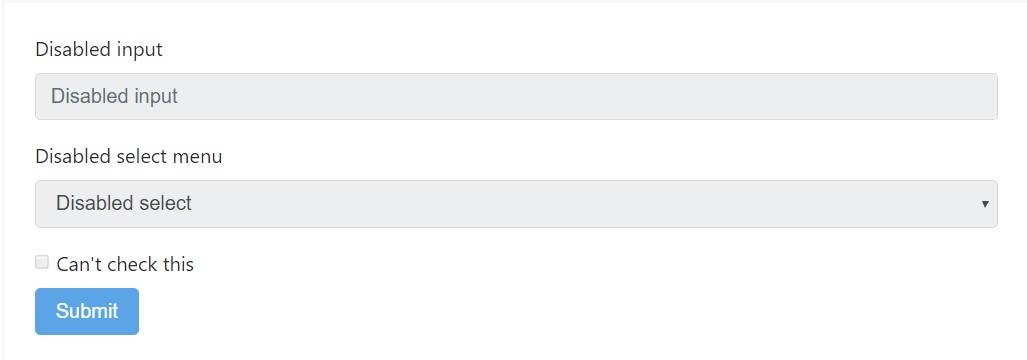
<form>
<fieldset disabled>
<div class="form-group">
<label for="disabledTextInput">Disabled input</label>
<input type="text" id="disabledTextInput" class="form-control" placeholder="Disabled input">
</div>
<div class="form-group">
<label for="disabledSelect">Disabled select menu</label>
<select id="disabledSelect" class="form-control">
<option>Disabled select</option>
</select>
</div>
<div class="checkbox">
<label>
<input type="checkbox"> Can't check this
</label>
</div>
<button type="submit" class="btn btn-primary">Submit</button>
</fieldset>
</form>Caveat regarding to web link performance of <a>
By default, browsers will handle all of the native form controls (<input>, <select> plus <button> elements) inside a <fieldset disabled> as disabled, blocking each of the key-board plus mouse interactions on them. But, supposing that your form additionally includes <a ... class="btn btn-*"> components, these will only be delivered a format of pointer-events: none. Just as considered inside the part on disabled state for buttons (and particularly in the sub-section for anchor features ), this specific CSS property is not actually yet standardised and isn't totally maintained in Opera 18 and below, or in Internet Explorer 11, and won't prevent key board users from having the capacity to focus or else trigger such hyperlinks. And so to be protected, work with custom made JavaScript to disable such hyperlinks.
Cross-browser being compatible
Even though Bootstrap will employ these particular styles in all internet browsers, Internet Explorer 11 and below do not totally sustain the disabled attribute on a <fieldset>. Make use of custom-made JavaScript to turn off the fieldset in these types of web browsers.
Read-only inputs
Add in the readonly boolean attribute upon an input to avoid alteration of the input's value. Read-only inputs appear lighter ( much like disabled inputs), however hold the standard pointer.

<input class="form-control" type="text" placeholder="Readonly input here…" readonly>Control scale
Set up heights using classes like .form-control-lg, plus set up widths applying grid column classes just like .col-lg-*.

<input class="form-control form-control-lg" type="text" placeholder=".form-control-lg">
<input class="form-control" type="text" placeholder="Default input">
<input class="form-control form-control-sm" type="text" placeholder=".form-control-sm">
<select class="form-control form-control-lg">
<option>Large select</option>
</select>
<select class="form-control">
<option>Default select</option>
</select>
<select class="form-control form-control-sm">
<option>Small select</option>
</select>Column sizes
Wrap inputs in a grid columns, or else any custom-made parent component, in order to easily put in force the desired widths.

<div class="row">
<div class="col-2">
<input type="text" class="form-control" placeholder=".col-2">
</div>
<div class="col-3">
<input type="text" class="form-control" placeholder=".col-3">
</div>
<div class="col-4">
<input type="text" class="form-control" placeholder=".col-4">
</div>
</div>Assist message
The .help-block class is lost in the new version. If you have to set a bit of supplemental text message to help your visitors to better get around - work with the .form-text class alternatively. Bootstrap 4 possesses certain built within validation styles for the form controls being used . Within this version the .has-feedback class has been simply dismissed-- it is really no longer needed with the introduction of the .form-control-danger, .form-control-warning and .form-control-success classes providing a tiny information icon right in the input fields.
Associating help text message along with form controls
Help content needs to be explicitly related to the form control it really relates to employing the aria-describedby attribute. This are going to make sure that the assistive technologies-- for example, screen readers-- will reveal this guide text message if the user focuses or else enters the control.
Block level
Block support content-- for below inputs as well as for extended lines of the support text message-- can possibly be easily achieved with .form-text. This specific class involves display: block and incorporates a bit of top margin to get simple spacing from the inputs mentioned above.

<label for="inputPassword5">Password</label>
<input type="password" id="inputPassword5" class="form-control" aria-describedby="passwordHelpBlock">
<p id="passwordHelpBlock" class="form-text text-muted">
Your password must be 8-20 characters long, contain letters and numbers, and must not contain spaces, special characters, or emoji.
</p>Inline
Inline text message can certainly utilize any type of common inline HTML feature (be it a , <span>, or another).

<form class="form-inline">
<div class="form-group">
<label for="inputPassword4">Password</label>
<input type="password" id="inputPassword4" class="form-control mx-sm-3" aria-describedby="passwordHelpInline">
<small id="passwordHelpInline" class="text-muted">
Must be 8-20 characters long.
</small>
</div>
</form>Validation
Bootstrap features validation varieties for warning, danger, and success states on a large number of form controls.
Tips on how to use
Here's a review of just how they function:
- To apply, incorporate .has-warning, .has-danger, or .has-success to the parent element. Any sort of .col-form-label, .form-control, or customized form feature will obtain the validation designs.
- Contextual validation text, alongside your standard form area support content, may be provided together with the utilization of .form-control-feedback. This particular text will adapt to the parent .has-* class. By default it simply provides a little bit of margin for spacing as well as a reworked color for each state.
- Validation icons are url()-s constructed via Sass variables which are related to background-image statements for each and every state.
- You may take your unique base64 PNGs or maybe SVGs by improving the Sass variables and also recompiling.
- Icons have the ability to likewise be disabled entirely simply by specifying the variables to none or commenting out the source Sass.
Specifying states
Commonly saying, you'll desire to apply a particular state for particular forms of responses:
- Danger is excellent for the moment there's a blocking or possibly needed field. A user has to submit this specific field appropriately to provide the form.
- Warning does the job successfully for input values which are in improvement, just like password strength, or else soft validation before a user tries to submit a form.
- And lastly, success is most suitable for conditions as you have per-field validation through a form and want to motivate a user throughout the other fields.
For instances
Here are some good examples of the aforementioned classes in action. First up is your basic left-aligned fields along with labels, guidance text message, and validation messaging.
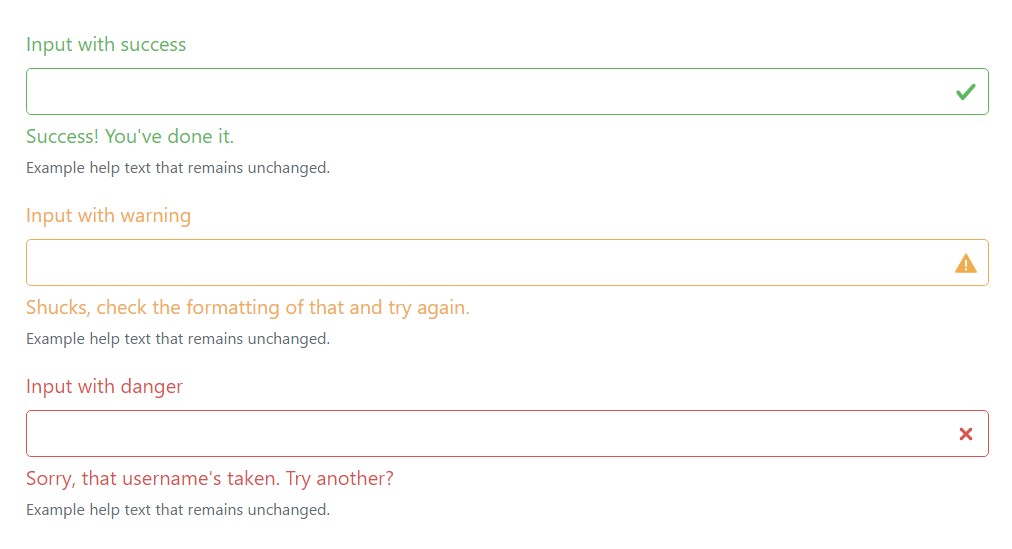
<div class="form-group has-success">
<label class="form-control-label" for="inputSuccess1">Input with success</label>
<input type="text" class="form-control form-control-success" id="inputSuccess1">
<div class="form-control-feedback">Success! You've done it.</div>
<small class="form-text text-muted">Example help text that remains unchanged.</small>
</div>
<div class="form-group has-warning">
<label class="form-control-label" for="inputWarning1">Input with warning</label>
<input type="text" class="form-control form-control-warning" id="inputWarning1">
<div class="form-control-feedback">Shucks, check the formatting of that and try again.</div>
<small class="form-text text-muted">Example help text that remains unchanged.</small>
</div>
<div class="form-group has-danger">
<label class="form-control-label" for="inputDanger1">Input with danger</label>
<input type="text" class="form-control form-control-danger" id="inputDanger1">
<div class="form-control-feedback">Sorry, that username's taken. Try another?</div>
<small class="form-text text-muted">Example help text that remains unchanged.</small>
</div>All those equal states have the ability to also be applied together with horizontal forms.
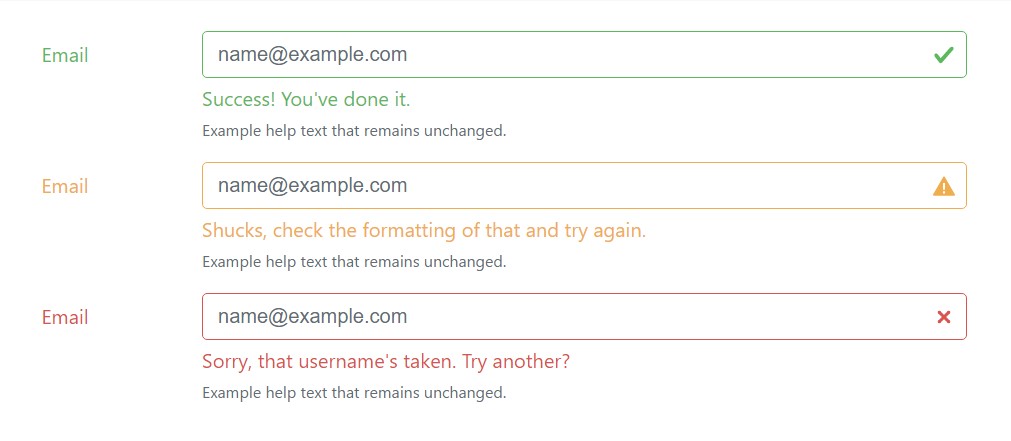
<div class="container">
<form>
<div class="form-group row has-success">
<label for="inputHorizontalSuccess" class="col-sm-2 col-form-label">Email</label>
<div class="col-sm-10">
<input type="email" class="form-control form-control-success" id="inputHorizontalSuccess" placeholder="[email protected]">
<div class="form-control-feedback">Success! You've done it.</div>
<small class="form-text text-muted">Example help text that remains unchanged.</small>
</div>
</div>
<div class="form-group row has-warning">
<label for="inputHorizontalWarning" class="col-sm-2 col-form-label">Email</label>
<div class="col-sm-10">
<input type="email" class="form-control form-control-warning" id="inputHorizontalWarning" placeholder="[email protected]">
<div class="form-control-feedback">Shucks, check the formatting of that and try again.</div>
<small class="form-text text-muted">Example help text that remains unchanged.</small>
</div>
</div>
<div class="form-group row has-danger">
<label for="inputHorizontalDnger" class="col-sm-2 col-form-label">Email</label>
<div class="col-sm-10">
<input type="email" class="form-control form-control-danger" id="inputHorizontalDnger" placeholder="[email protected]">
<div class="form-control-feedback">Sorry, that username's taken. Try another?</div>
<small class="form-text text-muted">Example help text that remains unchanged.</small>
</div>
</div>
</form>
</div>Radios and checkboxes happen to be as well provided.

<div class="form-check has-success">
<label class="form-check-label">
<input type="checkbox" class="form-check-input" id="checkboxSuccess" value="option1">
Checkbox with success
</label>
</div>
<div class="form-check has-warning">
<label class="form-check-label">
<input type="checkbox" class="form-check-input" id="checkboxWarning" value="option1">
Checkbox with warning
</label>
</div>
<div class="form-check has-danger">
<label class="form-check-label">
<input type="checkbox" class="form-check-input" id="checkboxDanger" value="option1">
Checkbox with danger
</label>
</div>Custom-made forms
For a lot more customization as well as cross web browser compatibility, use Bootstrap completely custom-made form components to change the internet browser defaults. They're constructed on very top of easily accessible and semantic markup, in this way they are really strong replacements for any type of default form control.
Disabled
Customized checkboxes and radios can additionally be disabled . Add in the disabled boolean attribute to the <input> plus the custom-made indicator and also label explanation will be automatically styled.

<label class="custom-control custom-checkbox">
<input type="checkbox" class="custom-control-input" disabled>
<span class="custom-control-indicator"></span>
<span class="custom-control-description">Check this custom checkbox</span>
</label>
<label class="custom-control custom-radio">
<input id="radio3" name="radioDisabled" type="radio" class="custom-control-input" disabled>
<span class="custom-control-indicator"></span>
<span class="custom-control-description">Toggle this custom radio</span>
</label>Validation forms
Bring in the various other states to your custom-made forms along with Bootstrap validation classes.

<div class="form-group has-success">
<label class="custom-control custom-checkbox">
<input type="checkbox" class="custom-control-input">
<span class="custom-control-indicator"></span>
<span class="custom-control-description">Check this custom checkbox</span>
</label>
</div>
<div class="form-group has-warning">
<label class="custom-control custom-checkbox">
<input type="checkbox" class="custom-control-input">
<span class="custom-control-indicator"></span>
<span class="custom-control-description">Check this custom checkbox</span>
</label>
</div>
<div class="form-group has-danger mb-0">
<label class="custom-control custom-checkbox">
<input type="checkbox" class="custom-control-input">
<span class="custom-control-indicator"></span>
<span class="custom-control-description">Check this custom checkbox</span>
</label>
</div>Stacked
Custom-made checkboxes and radios are inline to start. Bring in a parent together with class .custom-controls-stacked to make sure that each form control gets on various lines.

<div class="custom-controls-stacked">
<label class="custom-control custom-radio">
<input id="radioStacked1" name="radio-stacked" type="radio" class="custom-control-input">
<span class="custom-control-indicator"></span>
<span class="custom-control-description">Toggle this custom radio</span>
</label>
<label class="custom-control custom-radio">
<input id="radioStacked2" name="radio-stacked" type="radio" class="custom-control-input">
<span class="custom-control-indicator"></span>
<span class="custom-control-description">Or toggle this other custom radio</span>
</label>
</div>Select menu
Custom-made <select> menus need just a custom made class, .custom-select to activate the custom made styles.

<select class="custom-select">
<option selected>Open this select menu</option>
<option value="1">One</option>
<option value="2">Two</option>
<option value="3">Three</option>
</select>File internet browser
The file input is the much gnarly of the group and demand supplementary JavaScript in the case that you 'd like to hook them up with useful Choose file ... and selected file name text message.
<label class="custom-file">
<input type="file" id="file" class="custom-file-input">
<span class="custom-file-control"></span>
</label>Here’s tips on how to operate:
- We wrap the <input> inside a <label> so the custom control correctly triggers the file internet browser.
- We conceal the default file <input> using opacity.
- We work with : after to create a custom background and directive (Choose file ...).
- We work with :before to generate and position the Browser tab.
- We reveal a height on the <input> for proper spacing for surrounding material .
In other words, it is simply an absolutely custom feature, entirely developed with CSS.
Converting alternatively customing the sequences
The : lang() pseudo-class is employed to allow convenient interpretation of the "Browse" along with "Choose file ..." text into additional languages. Just simply override or bring in gates to the $ custom-file-text SCSS variable along with the related language mark along with localised strings. The English strings may possibly be customized the same way. For instance, here's precisely how one could bring in a Spanish interpretation (Spanish's language code is es)
$custom-file-text: (
placeholder: (
en: "Choose file...",
es: "Seleccionar archivo..."
),
button-label: (
en: "Browse",
es: "Navegar"
)
);You'll ought to prepare the language of your document ( or else subtree thereof) correctly needed for the correct text to be presented. This may be performed working with the lang attribute or else the Content-Language HTTP header, among various other approaches.
Conclusions
Fundamentally these are the brand new components to the form components added within the latest fourth version of the Bootstrap framework. The general thought is the classes got extra natural and straightforward for that reason-- much more convenient to work with and together with the customized control features we can now acquire far more predictable visual aspect of the elements we involve within the web pages we create. Currently everything that's left for us is identify the appropriate information we would need from our possible users to complete.
Exactly how to make use of the Bootstrap forms:
Linked topics:
Bootstrap forms main information
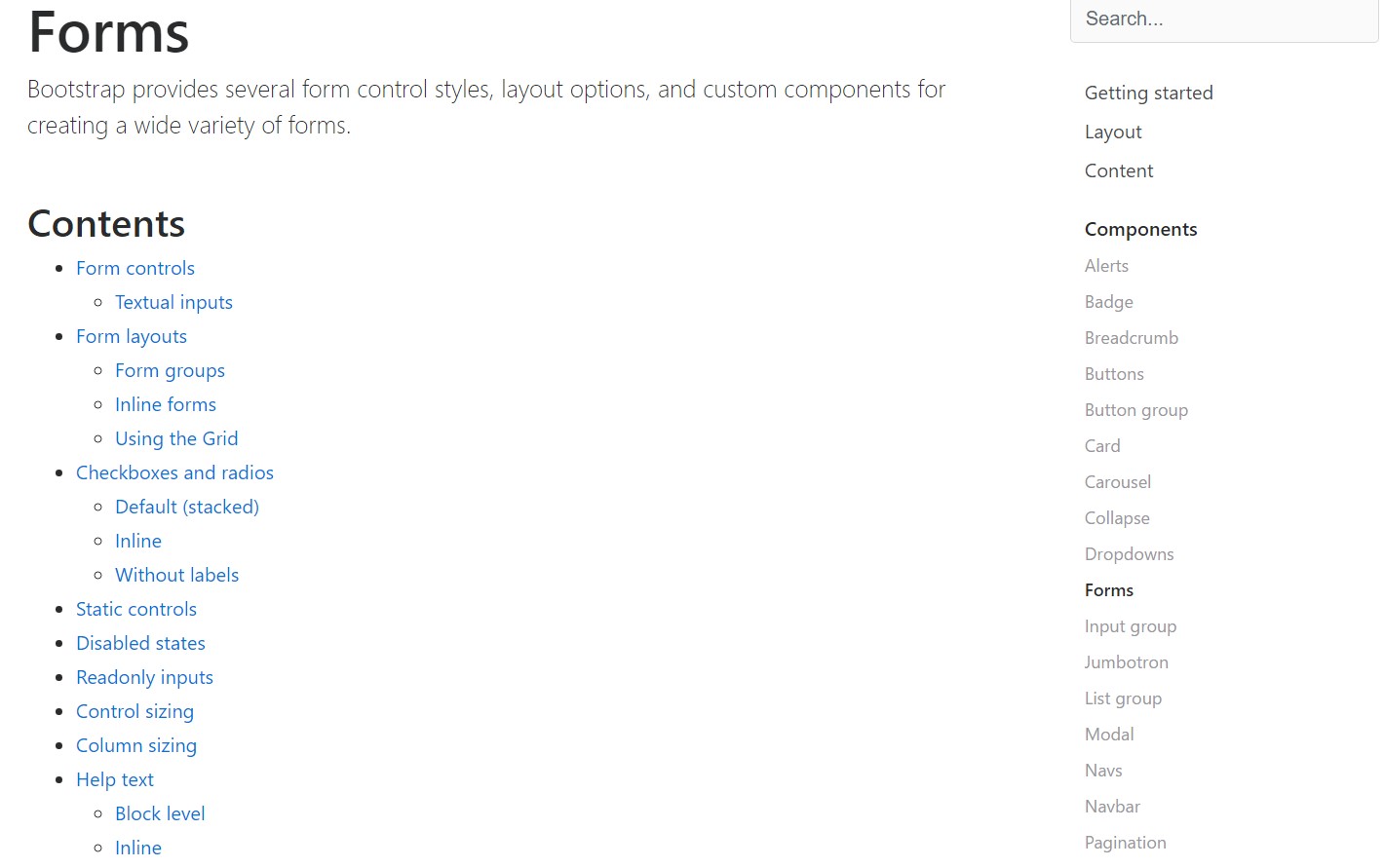
Bootstrap tutorial
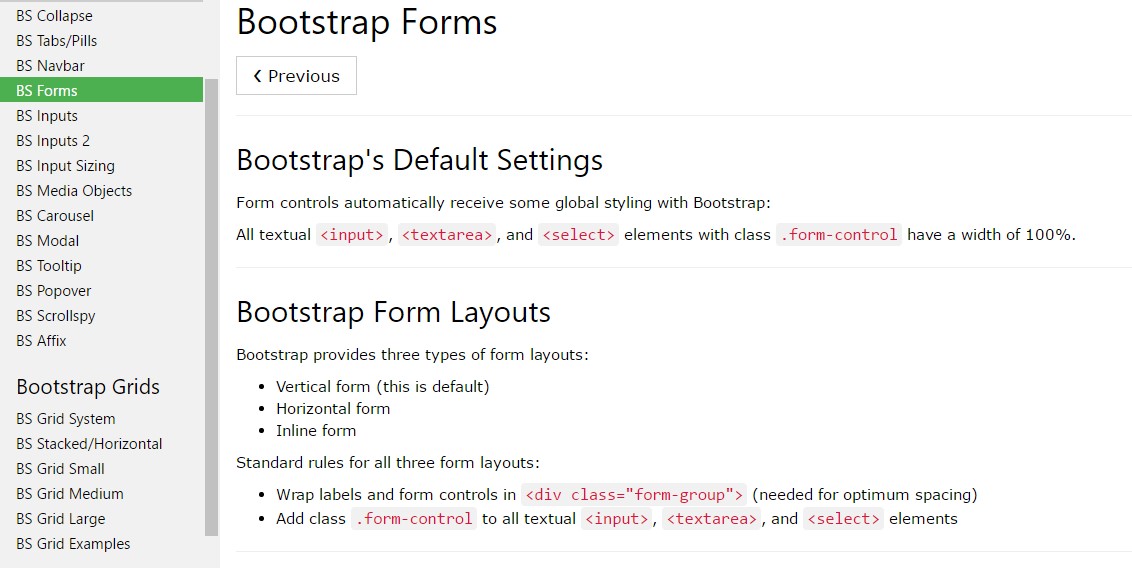
Support for Bootstrap Forms
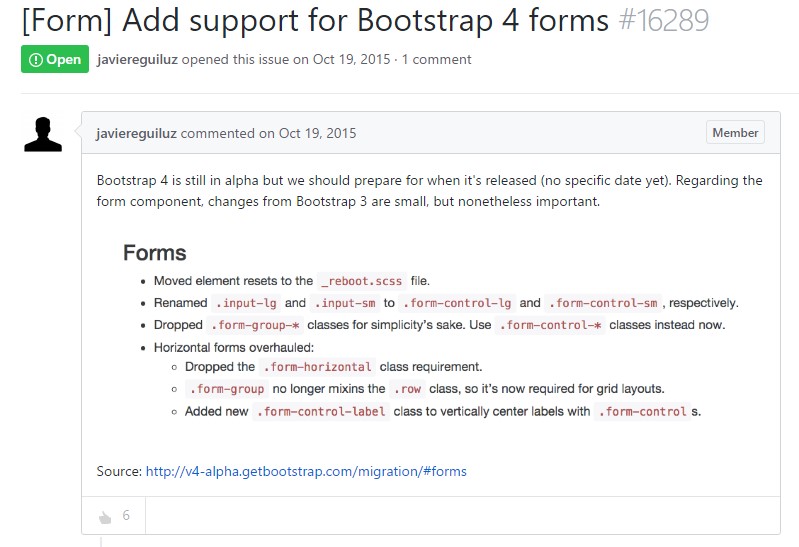
Let's examine AMP project and AMP-form component?
